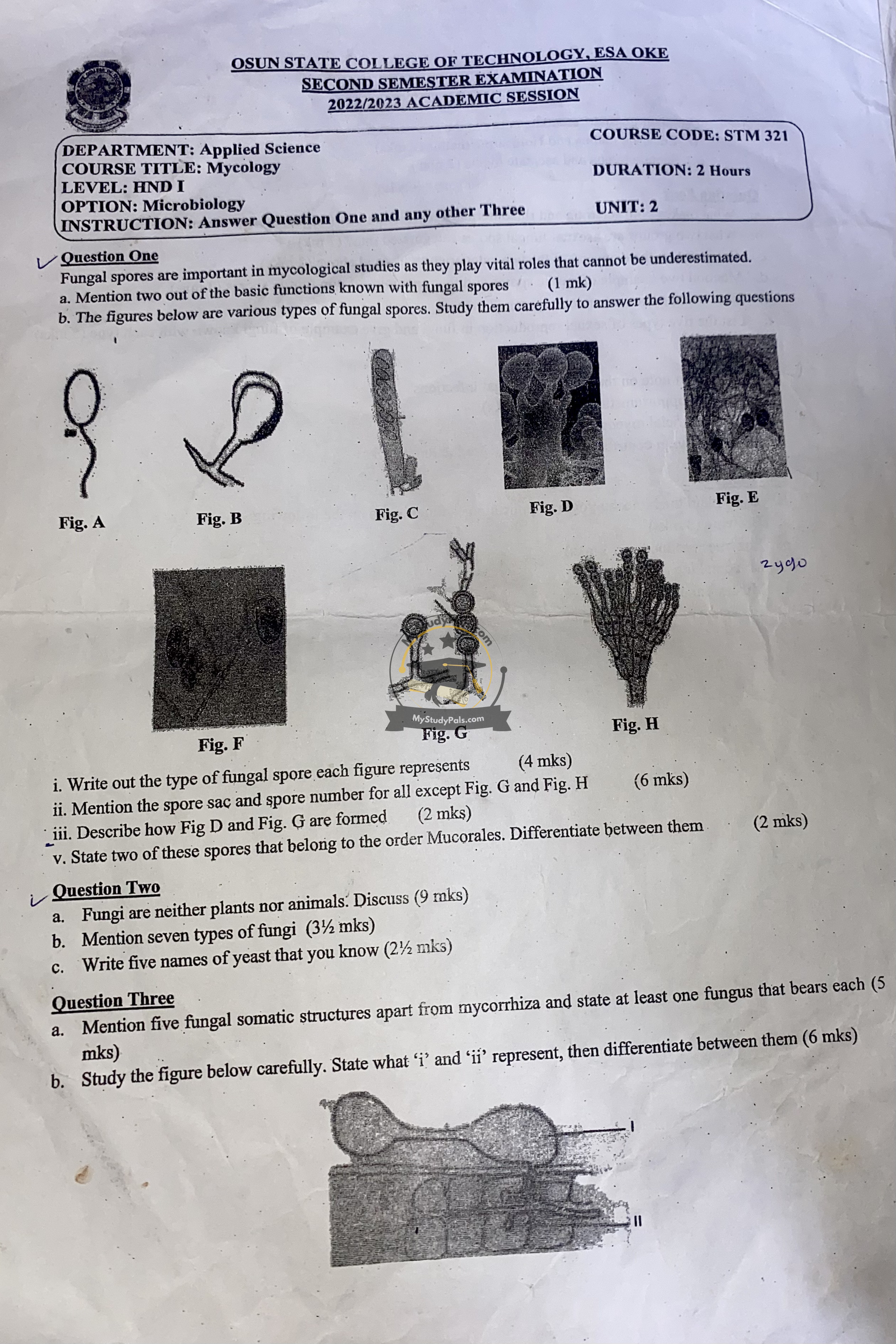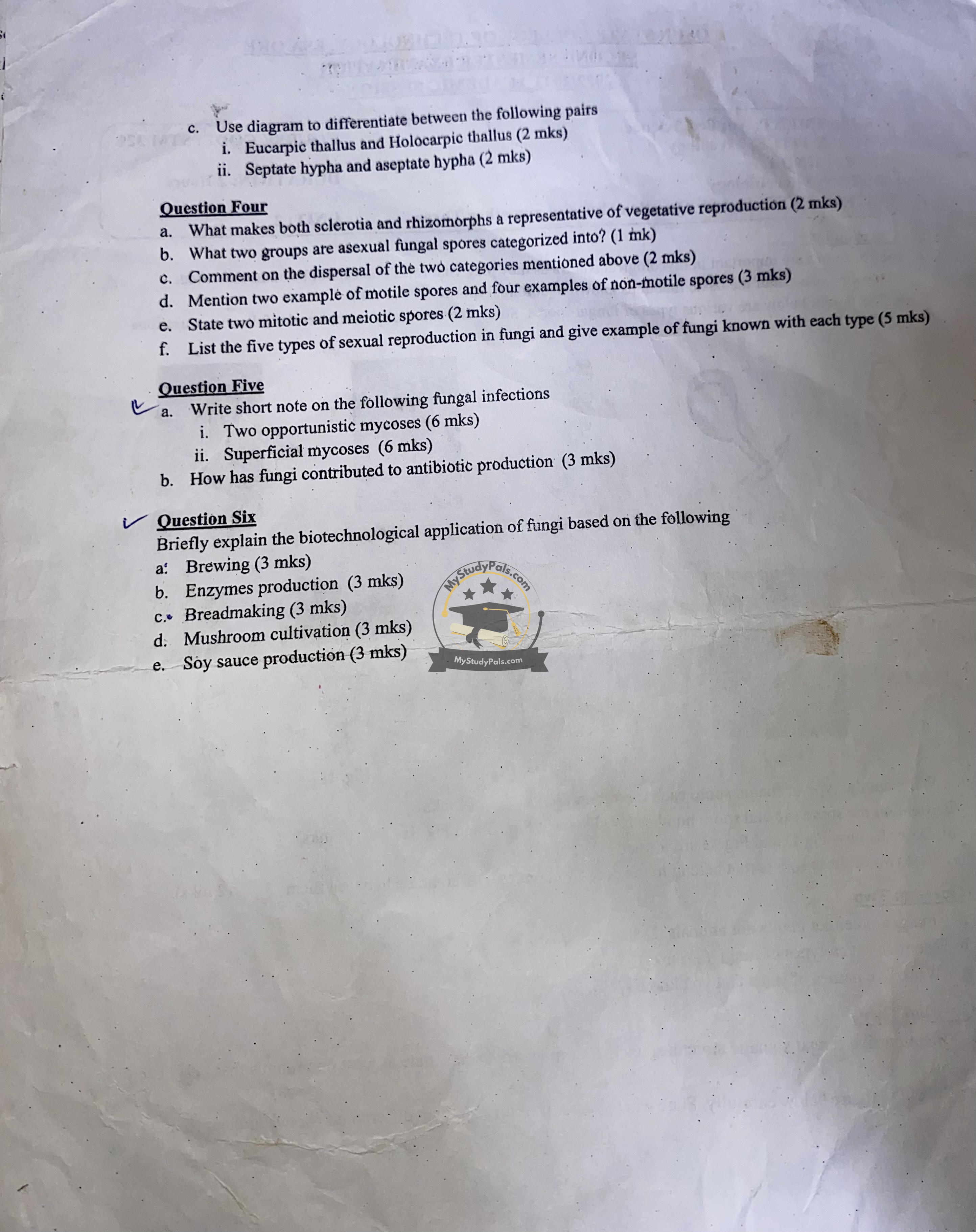ANWSER
Question 1:
Answer:
a. Two basic functions of fungal spores:
- Reproduction
- Dispersal
b. Types of fungal spores represented in each figure:
- Fig. A: Chlamydospore
- Fig. B: Blastospores
- Fig. C: Arthrospore
- Fig. D: Sporangiospore
- Fig. E: Conidiospore
- Fig. F: Conidiospore
- Fig. G: Zygospore
- Fig. H: Conidiophore bearing conidia
ii. Spore sac and number:
- Fig. A: No sac; single spore
- Fig. B: No sac; single spore
- Fig. C: No sac; fragmented hyphae
- Fig. D: Present (sporangium); multiple spores
- Fig. E: No sac; chains of conidia
- Fig. F: No sac; multiple conidia
iii. Formation of spores:
- Fig. D (Sporangiospores): Formed inside a sporangium on a sporangiophore through asexual reproduction.
- Fig. G (Zygospore): Formed by the fusion of two compatible hyphae during sexual reproduction (gametangial fusion).
iv. Two spores that belong to Mucorales and their differences:
- Sporangiospores (Fig. D) – Asexual spores produced in a sporangium
- Zygospores (Fig. G) – Sexual spores formed by fusion of gametangia
Differences: - Sporangiospores are asexual, produced rapidly
- Zygospores are thick-walled resting spores, formed sexually
Question 2:
Answer:
a. Fungi are neither plants nor animals:
Fungi are a separate kingdom of eukaryotic organisms distinct from plants and animals. They are heterotrophic like animals but have a cell wall like plants (made of chitin, not cellulose). Unlike plants, they do not perform photosynthesis. Their mode of nutrition is absorptive, secreting enzymes to break down complex substances externally. Fungi reproduce both sexually and asexually and have unique structures such as hyphae and mycelium.
b. Seven types of fungi:
- Zygomycota
- Ascomycota
- Basidiomycota
- Chytridiomycota
- Deuteromycota (Fungi Imperfecti)
- Oomycota
- Glomeromycota
c. Five names of yeast:
- Saccharomyces cerevisiae
- Candida albicans
- Cryptococcus neoformans
- Pichia pastoris
- Schizosaccharomyces pombe
Question 3:
Answer:
a. Five fungal somatic structures apart from mycorrhiza and fungi that bear them:
- Hyphae – Rhizopus spp.
- Mycelium – Penicillium spp.
- Rhizoid – Mucor spp.
- Sclerotia – Claviceps purpurea
- Rhizomorphs – Armillaria spp.
b.
- ‘i’ represents Sporangium
- ‘ii’ represents Sporangiophore
Difference: - Sporangium is a sac-like structure where spores are produced.
- Sporangiophore is the stalk that holds the sporangium.
c.
i. Difference between Eucarpic and Holocarpic thallus:
- Eucarpic: Only part of the thallus differentiates into reproductive structures.
- Holocarpic: Entire thallus converts into a reproductive structure.
ii. Difference between Septate and Aseptate hyphae:
- Septate hyphae have cross-walls (septa) dividing cells.
- Aseptate (coenocytic) hyphae lack septa and are multinucleated.
Question 4:
Answer:
a. Sclerotia and rhizomorphs are vegetative reproductive structures because they help fungi survive harsh conditions and regenerate when favorable.
b. Two groups of asexual fungal spores:
- Sporangiospores
- Conidiospores
c. Dispersal of spores:
- Motile spores use flagella to swim through water.
- Non-motile spores rely on wind, water, or animals for dispersal.
d. Motile spores:
- Zoospores
- Planospores
Non-motile spores: - Conidiospores
- Sporangiospores
- Chlamydospores
- Arthrospores
e. Mitotic and meiotic spores:
- Mitotic: Formed by mitosis (e.g., conidia, sporangiospores)
- Meiotic: Formed by meiosis during sexual reproduction (e.g., ascospores, basidiospores)
f. Five types of sexual reproduction in fungi and examples:
- Gametogamy – Zygomycota
- Gametangiogamy – Rhizopus
- Somatogamy – Basidiomycota
- Spermatization – Neurospora
- Planogametic Copulation – Chytridiomycota
Question 5:
Answer:
a.
i. Opportunistic mycoses:
- Candidiasis
- Aspergillosis
ii. Superficial mycoses:
- Tinea versicolor
- Tinea nigra
b. Fungi in antibiotic production:
- Penicillium notatum produces penicillin
- Cephalosporium spp. produces cephalosporin
Question 6:
Answer:
a. Brewing – Saccharomyces cerevisiae ferments sugars into alcohol in beer and wine production.
b. Enzymes production – Fungi like Aspergillus niger produce industrial enzymes (e.g., amylase, cellulase).
c. Breadmaking – Yeasts such as S. cerevisiae produce CO₂, causing dough to rise.
d. Mushroom cultivation – Edible mushrooms like Agaricus bisporus are cultivated for food.
e. Soy sauce production – Aspergillus oryzae is used to ferment soybeans in traditional soy sauce making.



